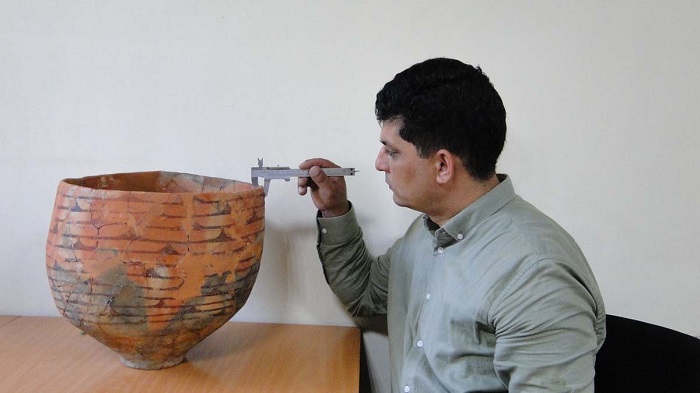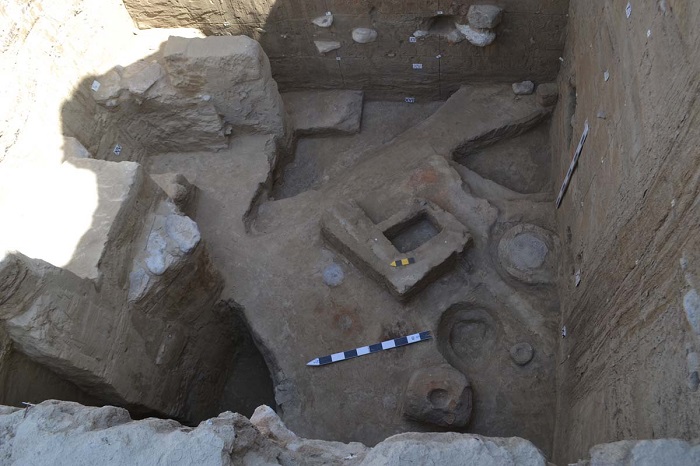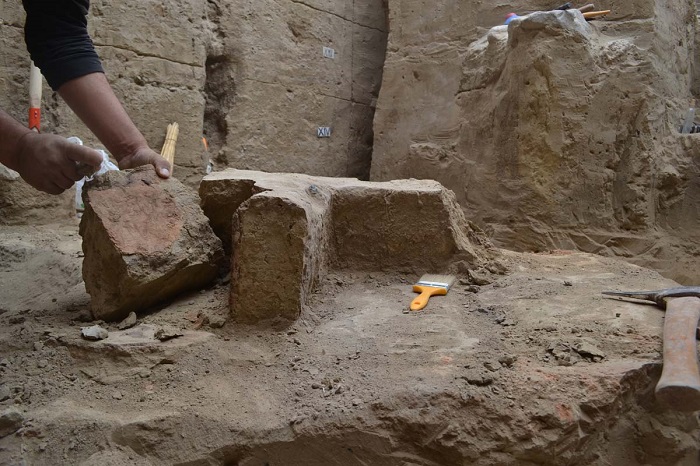 Recep Jommyev,
Recep Jommyev,
archaeologist, Senior Researcher at the Institute of History and Archaeology of the Academy of Sciences
Archaeological excavations commenced at the historical and cultural site of Parz-depe this spring, focusing on a comprehensive study of the stratigraphy of its cultural layers. The goal was to determine the periods of human habitation and uncover information about the economic and cultural connections of the ancient population.
Excavations began at the highest point of the monument and progressed downward to the untouched substrate, covering a substantial timeframe in the development of the Parz-depe culture.
To analyze the layers and cultural deposits in the southeastern part of the inner citadel, a previously explored 4×4-meter pit was cleared further. The excavations reached a depth of 8.5 meters, extending to the 16th tier. Research began at the 12th tier, where ceramic shards characteristic of the Eneolithic period were discovered.
Further exploration revealed walls dating back to the 13th tier, measuring 48 cm in height and 28 cm in width. These walls indicate the uniform age of the 12th and 13th tiers, supported by the presence of cattle bones and pot fragments. It is believed that these tiers belong to the Late Eneolithic period (2.7-0.5 thousand years BC).
In the 14th tier, archaeologists unearthed a two-chamber hearth measuring 100 x 77 cm with preserved walls reaching 20-21 cm in height. The hearth exhibited signs of long-term use, with multiple updates and plastering of its walls. The inner wall was constructed of clay and small ceramic fragments, without the use of pebbles, suggesting advancements in hearth manufacturing techniques. The outer sides bore evidence of frequent exposure to fire, indicating its active use.
On the eastern side of the hearth, in its southwestern part, the remains of a child wearing a necklace were discovered, possibly indicating a ritual burial.
At the level of the 15th tier, three Eneolithic pots were found beneath a two-chamber hearth that had been damaged by fire. One of these vessels was adorned with triangular figures resembling river waves and framed by twelve lines, offering valuable insights into the early art of the era. The pots were restored to their original state and are slated to be transferred to the Arkadag Historical Museum, as the Parz-depe monument is located within the city’s territory.
During the stratigraphic study at a depth of 16 tiers, numerous artifacts were unearthed, including ceramic fragments, small cattle bones, and a copper product resembling a miniature spoon measuring 8 x 11 cm. A chemical analysis was conducted to determine the metal’s composition. Fragments of clay walls and vessels dating back to the Early Eneolithic were also discovered at this level.
In conclusion, the ceramics found in the layers of Parz-depe demonstrate the evolution of production technology and decoration. Ceramic products from various periods showcase continuous advancements, highlighting the significant role of Parz-depe in the development of pottery in the region. The patterns characteristic of the Chalcolithic era, such as triangular shapes and wavy lines, reflect the artistic and cultural traditions of that time.
The excavations also revealed that during the period of residence on the territory of Parz-depe, new buildings were built on the site of old buildings that served as the foundation for new structures. This process led to the formation of a cultural layer of considerable thickness and the formation of a hill on which settlements existed. An example of this approach to construction is the discovered walls and pots that were under new buildings, which confirms the continuity of living in this place. The study of “Parz-depe” continues. ///originally published on the website “Turkmenistan: The Golden Age”, 17 October 2024

